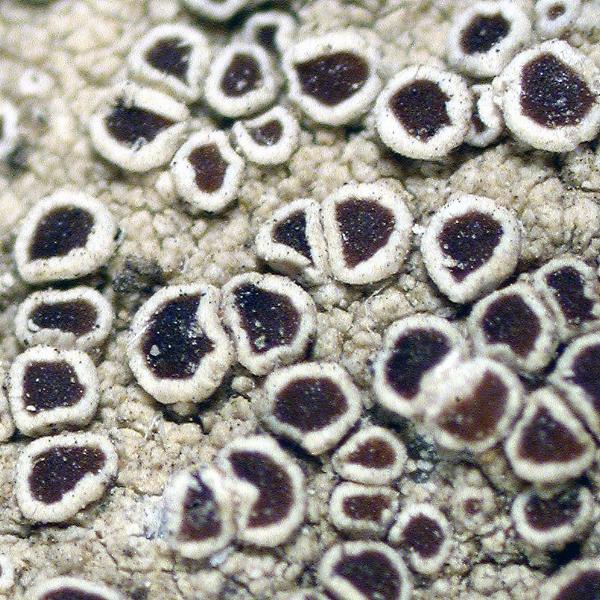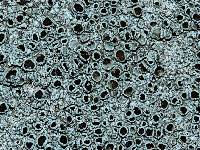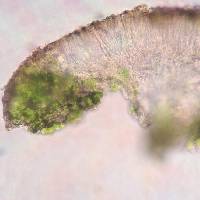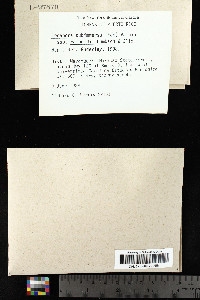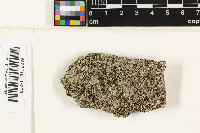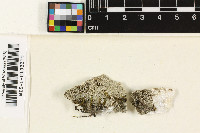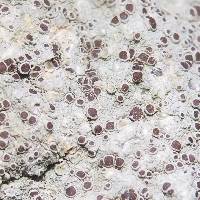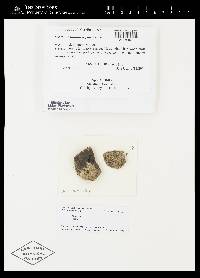
- Home
- Search
- Images
- Species Checklists
- US States: O-Z >
- US National Parks
- Central America
- South America
- US National Parks
- Southern Subpolar Region
|
|
|
|
Family: Lecanoraceae
|
MycoBank no. 389344 Type: Japan. Kozuke Province: exact locality unknown, 19-Feb-1918, Yasuda, A. 355 (TUR-V 6093–holotype, BM–isotype). Description. Thallus saxicolous, thick, rimose to rimose areolate, areoles granular to densely verrucose or bullate; surface white to pale gray, yellowish gray or pale brownish gray, roughened, matt, epruinose or with sparse, whitish pruina, lacking soredia; prothallus faintly developed, powdery arachnoid to compact, generally white, but occasionally blackening and forming a line where different thalli meet. Apothecia numerous, often densely aggregated, circular to slightly irregular in outline, often deformed by mutual pressure, 0.4–1.4 mm in diam., adnate to soon sessile and then ±constricted, distinctly lecanorine, margin persistent, entire to barely undulating, smooth, crenate or verruculose, epruinose to barely whitish pruinose, concolorous with the thallus, disc plane to ±convex, deep mahogany brown to almost black, epruinose to faintly whitish pruinose; hymenium hyaline, not inspersed; epihymenium lacking crystals, with a diffuse pale to dark reddish brown pigment (arnoldiana-brown: K+ dull brown, HCl+ reddish brown, N−), pigment persistent in K (glabrata-type); proper exciple thin, indistinct, with few crystals; thalline exciple thick, distinctly corticate, with many large crystals insoluble in K and sparse small crystals soluble in K (pulicaris-type); hypothecium hyaline; ascospores 8/ascus, simple, ellipsoid, (7.9)–9.5–12.8–(14.9) × (4.0–)4.9–6.5(–6.9) μm (n = 45). Pycnidia not seen. Chemistry. Thallus cortex including apothecial margin P+ yellow, C−, KC−, K+ yellow; with atranorin [major], zeorin [major], unknown terpenes [minor], ±xanthone 54 [minor]; [specimen analyzed with TLC: Bungartz, F. 7600 (CDS 38096)]. Ecology and distribution. Almost cosmopolitan (North and South America, Asia, Australia), new to Ecuador and the Galapagos; only few specimens were found on exposed rock outcrops in the humid and high-altitude dry zone of Volcán Alcedo, Isabela. Notes. This species has not previously been reported for Galapagos (Guderley 1999) and specimens growing on rock were initially identified as L. tropica; the two taxa are very similar and might even be conspecific (see notes on L. tropica).
Nash, T.H., Ryan, B.D., Gries, C., Bungartz, F., (eds.) 2004. Lichen Flora of the Greater Sonoran Desert Region. Vol 2. Thallus: crustose, continuous or rimose-areolate; prothallus: white areoles: flat, thin, opaque, ecorticate surface: yellowish white to yellowish gray or whitish gray to gray or pale green to greenish white, smooth, epruinose; with an indistinct or zonate margin, esorediate Apothecia: subimmersed when young, sessile when mature or sessile, 0.4-1.4 mm in diam., lecanorine disc: red-brown, plane, epruinose margin: concolorous with thallus, thick, persistent, even, not flexuose, rough, entire or verrucose or verruculose, without a parathecial ring amphithecium: present, with numerous algal cells, with large crystals insoluble in K, corticate; cortex: indistinct, basally not thickened, gelatinous or interspersed, hyaline, (15-)20-25(-30) µm thick parathecium: hyaline, containing crystals soluble in K epihymenium: without crystals, with pigment not dissolving in K hymenium: hyaline, clear; paraphyses: red-brown to orange-brown, slightly thickened (up to 3 µm wide) apically; subhymenium: hyaline, 15-20 µm thick; hypothecium: hyaline, without oil droplets asci: clavate, 8-spored ascospores: hyaline, simple, ellipsoid, (10-)10.5-14.5(-15) x (5-)5.5-7.5(-8) µm; wall: less than 1 µm thick Pycnidia: immersed, cerebriform; conidiophores: type II sensu Vobis conidia: filiform, 15-18 µm long Spot test: thallus and apothecial margin K+ yellow, C-, KC-, P+ yellow Secondary metabolites: containing atranorin (major), chloroatranorin (trace), zeorin (major) and traces of unidentified terpenes. Substrate and ecology: on somewhat shaded siliceous rocks World distribution: subcosmopolitan, known from Asia, Australasia, North and South America Sonoran distribution: Arizona, Chihuahua and Sonora. Notes: Lecanora subimmergens is characterized by its egranulose epihymnium, large amphithecial crystals, the presence of zeorin, and the continuous to rimose thallus. It is similar to L. campestris, but readily distinguishd by its large amphithecial crystals. Morphotypes of L. pseudistera may also be simlar, but can be distingished by the presence of the 2'-O-methylperlatolic acid chemosyndrome, the absence of zeorin, and the verrucose thallus. |
|
|
|

